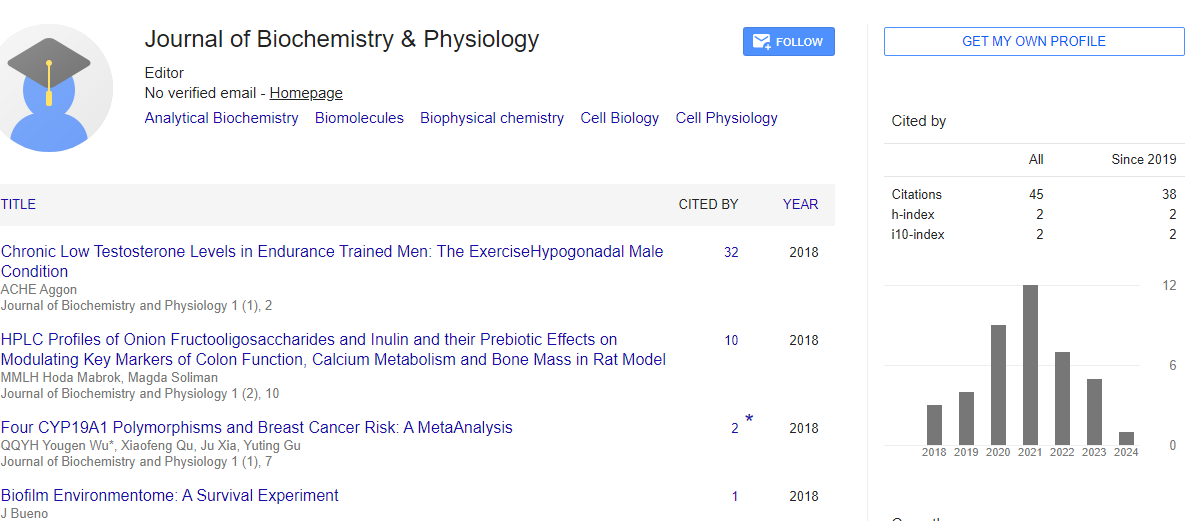Mini Review, J Biochem Physiol Vol: 7 Issue: 3
The Impact of Airway Epithelial Cells on Asthma Pathogenesis and Progression
Arian Baniassadi*
1Walter Payton College Preparatory High School, Chicago, Illinois, USA
*Corresponding Author: Arian Baniassadi,
Walter Payton College Preparatory High School, Chicago, Illinois, USA
E-mail: abaniassadi77@gmail.com
Received date: 06 September, 2024, Manuscript No. JBPY-24-147478;
Editor assigned date: 09 September, 2024, PreQC No. JBPY-24-147478 (PQ);
Reviewed date: 23 September, 2024, QC No. JBPY-24-147478;
Revised date: 01 October, 2024, Manuscript No. JBPY-24-147478 (R);
Published date: 09 October, 2024, DOI: 10.4172/jbpy.1000167.
Citation: Baniassadi A (2024) The Impact of Airway Epithelial Cells on Asthma Pathogenesis and Progression. J Biochem Physiol 7:3.
Abstract
Asthma is a chronic inflammatory disease of the airways characterized by airway hyperreactivity, inflammation and remodeling. Recent studies have underlined the critical role of airway epithelial cells in the pathogenesis and progression of asthma. This review describes the role of airway epithelium, its response to environmental insults and how it communicates with other cell types involved in asthma. Further, it will discuss how epithelial cell dysfunction worsens asthma and what potential therapy targets may exist within epithelial pathways.
Keywords: Asthma, Hyper reactivity, Epithelial cells, Epithelial pathways
Introduction
Asthma is a very complex respiratory illness and it continues to affect many people worldwide. The disease's hallmark symptoms are wheezing, breathlessness and coughing in episodic bouts. Conventionally, the center of attention in asthma research has been immune cells and inflammation. However, the airway epithelium, the first line of defense against inhaled environmental triggers, has become an essential player in asthma pathogenesis. The manuscript discusses the dissection of the role of airway epithelial cells in asthma, focusing on their contributions to the initiation and progression of the disease and potential avenues of therapy.
Airway epithelium: Structure and function
Anatomy of the airway epithelium: The airway epithelium is a pseudostratified columnar epithelium lining the airways. It includes ciliated, goblet, basal and neuroendocrine cells. The epithelial layer provides the physical barrier and participates actively in mucociliary clearance, pathogen recognition and local immunoreactivity [1].
Barrier function epithelial: Tight junctions connect cells, preventing harmful particles and pathogens from penetrating the epithelium. Compromise in tight junctions can lead to increased permeability of the epithelium or underlying tissue, exposing it to allergens and irritants [2].
Epithelial cell response to environmental triggers
Allergens and irritants: Stimulation of airway epithelial cells by allergens, such as pollen or dust mites and irritants, such as tobacco smoke or air pollution, leads to their activation. Their activation involves the release of pro-inflammatory cytokines, chemokines and growth factors that will attract and activate immune cells.
Activation of the epithelium: Allergen-driven epithelial activation produces and releases cytokines like IL-33, IL-25 and Thymic Stromal Lymphopoietin (TSLP), which contribute to developing Th2-driven inflammation. It also activates Porcine Reproductive and Respiratory Syndrome (PRRs), including Toll-like Receptors (TLRs), on the surface of epithelial cells, further amplifying the inflammatory response [3,4].
Airway epithelial dysfunction in asthma
Disruption of the epithelial barrier: The epithelium is usually disrupted in asthmatic patients, predisposing them to airway hyper reactivity and allergens [5]. Epithelial shedding and apoptosis lead to barrier dysfunction and increased asthma symptoms.
Epithelial remodeling: Long-term asthma may also lead to some structural features in the airway epithelium, including increased goblet cell hyperplasia and subepithelial fibrosis. These features are associated with mucus hypersecretion and airway narrowing, characteristic features of asthma [6].
Interaction between the epithelium and the immune cells
Cells interact with many immune cells, including mast cells, eosinophils and T lymphocytes. This, in turn, affects the profile of cytokines and chemokines produced by epithelial cells, which, through an autocrine inflammatory feedback loop, influences immune cell activation and recruitment [2].
Epithelial derived mediators: Mediators flow from the epithelium include extracellular matrix components and growth factors contributing to airway remodeling and inflammation [7].
Therapeutic implications
Targeting epithelial dysfunction: Restoration of epithelial barrier function and reduction in inflammation are considered approaches. Barrier repair agents and anti-inflammatory drugs are included in this process. Modifying epithelial cell responses to allergens and other irritants may provide new approaches to asthma management [8].
Novel therapies: Research now includes treatments targeted at the epithelium, such as those inhibiting cytokine release or inducing mechanisms protecting against epithelial injury. Various biological targeting specific epithelial derived mediators are under investigation for their potential in alleviating asthma symptoms.
Conclusion
The airway epithelium is at the forefront of the structural changes within the asthmatic airways and significantly contributes to the pathogenesis and progression of asthma. Understanding how epithelial cells contribute to asthma provides insights into possible therapeutic strategies. Further studies are needed regarding the interaction between epithelial cells and the immune system to determine new therapeutic options for asthma.
References
- Holgate ST (2008) The airway epithelium is central to the pathogenesis of asthma. Allergol Int 57(1):1-3.
[Crossref] [Google Scholar] [PubMed]
- Pelaia C, Melhorn J, Hinks TS, Couillard S, Vatrella A, et al. (2024) Type 2 severe asthma: Pathophysiology and treatment with biologics. Expert Rev Respir Med 18(7):485-498.
[Crossref] [Google Scholar] [PubMed]
- Lambrecht BN, Hammad H (2012) The airway epithelium in asthma. Nat Med 18(5):684-692.
[Crossref] [Google Scholar] [PubMed]
- Holgate ST (2007) Epithelium dysfunction in asthma. J Allergy Clin Immunol 120(6):1233-1244.
[Crossref] [Google Scholar] [PubMed]
- Gon Y, Hashimoto S (2018) Role of airway epithelial barrier dysfunction in pathogenesis of asthma. Allergol Int 67(1):12-17.
[Crossref] [Google Scholar] [PubMed]
- Holgate ST (2011) The sentinel role of the airway epithelium in asthma pathogenesis. Immunol Rev 242(1):205-219.
[Crossref] [Google Scholar] [PubMed]
- Holgate ST, Davies DE, Puddicombe S, Richter A, Lackie P, et al. (2003) Mechanisms of airway epithelial damage: Epithelial-mesenchymal interactions in the pathogenesis of asthma. Eur Respir J Suppl 22(44 suppl):24-29.
[Crossref] [Google Scholar] [PubMed]
- Whitsett JA, Alenghat T (2015) Respiratory epithelial cells orchestrate pulmonary innate immunity. Nat Immunol 16(1):27-35.
[Crossref] [Google Scholar] [PubMed]
 Spanish
Spanish  Chinese
Chinese  Russian
Russian  German
German  French
French  Japanese
Japanese  Portuguese
Portuguese  Hindi
Hindi 